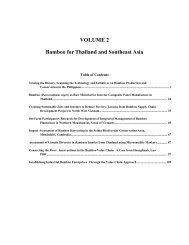WBC-VIII-Vol.4 – Resources – Forestry, Plantations and ... - BambuSC
WBC-VIII-Vol.4 – Resources – Forestry, Plantations and ... - BambuSC
WBC-VIII-Vol.4 – Resources – Forestry, Plantations and ... - BambuSC
Create successful ePaper yourself
Turn your PDF publications into a flip-book with our unique Google optimized e-Paper software.
Oxytenanthera stocksii<br />
Pleoblastus variegata<br />
P. green<br />
Pseudosasa japonica<br />
Drepanostachyum falcatum<br />
The bamboo planting stock is now being produced through tissue culture on a large scale in various parts of the<br />
country. The planting material has been tested in multi-locational trials. A national certification system is in<br />
place <strong>and</strong> it is imperative that any large-scale plantation of bamboo should necessarily source its material from<br />
superior genotypes identified <strong>and</strong> to the extent possible only certified tissue culture raised material should be<br />
used for obtaining best performance in field.<br />
St<strong>and</strong>ardization of Silvicultural <strong>and</strong> Plantation Management practices<br />
Raising of <strong>Plantations</strong><br />
Bamboo plantations should be raised with intensive management <strong>and</strong> planed planting schemes like cultivation of<br />
any other cash crops to enhance the yield per annum to a predetermined level. Usually bamboo prefers welldrained<br />
soils of s<strong>and</strong>y loams to loamy clay type, however, individual species have well defined habitats.<br />
Maintenance activities should be concentrated on protecting the young plants from competition for the first two<br />
years after that clump management operations are required. The bamboo plantation achieves its optimum<br />
productive stage generally by 4 -7 year as in case of sympodial bamboo <strong>and</strong> continued till the st<strong>and</strong> attains an<br />
age of around 20-25 years. After that the uprooting of entire plantation is suggested in phased manner for raising<br />
new plantations.<br />
Management Practices<br />
Management of bamboo st<strong>and</strong>s is relatively simple <strong>and</strong> closely related to the striking generic <strong>and</strong> cultural<br />
features. In general, the mature culms are cut <strong>and</strong> regeneration obtained from new culms produced annually<br />
from underground rhizomes, <strong>and</strong> this practice followed everywhere regardless of the species <strong>and</strong> type of forest.<br />
However, some more points are as:<br />
Soil working around the Clumps: New rhizomes of bamboo emerge at an upwardly inclined angle from the base<br />
of clump. During the period of emergence <strong>and</strong> growth any exposure to sunlight stops the rhizome development.<br />
Hence, it is advisable to raise the soil (make mounds) around the clumps every year before the new culms<br />
emergence. Such soil working also increases the number of new culms emergence.<br />
Pruning: This is practiced only in those species which produce thorny branches like Bambusa bamboos. This<br />
should be started in the third year after planting. Pruning prevents congestion <strong>and</strong> helps in keeping the clump in<br />
working condition. All the branches up to 1.5 m height should be pruned leaving one node on the branch stalk.<br />
Thinning/ Improvement cutting: This practice should be started in the second year after planting <strong>and</strong> continued<br />
every year before the onset of rains. All malformed <strong>and</strong> damaged culms should be removed. Culms causing<br />
<strong>VIII</strong> World Bamboo Congress Proceedings Vol 4-22




